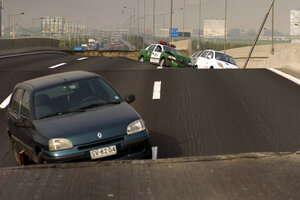Chile earthquake: Chileans dig out after 8.8-magnitude earthquake
Chile's earthquake was much stronger than the recent one in Haiti. Damage is extensive, residents and officials report. But so far, the death toll is much lower.

Vehicles sit on a destroyed motorway in Santiago, Chile after Saturday's earthquake.
Carlos Espinoza/AP
Santiago, Chile and Mexico City
Chileans remained dazed after an 8.8-magnitude earthquake struck the South American nation early Saturday, leaving homes destroyed and scores dead. But by midday they began digging out from the damage, hoping that it remained contained.
Chilean President-elect Sebastian Pinera said 122 people had been killed, but that the death toll could climb.
In the capital city, Santiago, which is 200 miles northeast of the epicenter, Jose Emilio Ortiz, who parks cars for a living, says that he rushed to his doorframe as windows broke throughout his house.
IN PICTURES: Images from the 8.8 magnitude earthquake in Chile
'I thought this was the end'
“I thought this was the end,” says Mr. Ortiz, who has lived through previous quakes, but says this is the strongest he has ever felt. He rushed to a bench outside his home, where he has remained ever since, as residents fear powerful aftershocks.
Chile sits in the “ring of fire” earthquake zone around the Pacific Rim, and it has a long history of earthquakes, including the strongest on record which struck in 1960. It was a 9.5 magnitude quake that struck near Validvia and left 1,655 dead.
This quake raised fears of tsunamis across the Pacific.
In Chile, the hardest hit city was Concepcion – the US Geological Survey said the epicenter was 70 miles northeast of the city – where local news reported a 15-story building collapsed, as well as bridges, and that highways were cracked. The airport in Santiago will be shut for at least 24 hours.
In Santiago, panic struck initially, as windows were shattered, and homes destroyed. Windowsill flowerpots crumbled, and pieces of brick, concrete, and roof tile lay strewn in the streets. Chunks of material from iconic buildings, such as the Bellas Artes museum and Universidad Catholic building, fell. Electricity was out through the morning.
Stephen Lynch, an American who has lived in Santiago for three years, says the earthquake seemed to last far longer than it did.
“There was nowhere to get away from it. You just stand in the doorway like they always tell you, like you see in the movies. But it was surprising how long it went on,” says Mr. Lynch. “It sounds like a cliché, but it really seemed like it went on for about an hour.”
For many, back to business as usual
By midday Saturday, however, many residents were back to business as usual. In the morning, residents were in the streets, clearing the rubble. Fruit sellers were in the streets selling their products. Corner stores reopened. Buses were circulating. And with the return of electricity, downtown traffic returned to normal.
Victoria Hermosilla Silva, a resident outside of Santa Barbara in the countryside, closer to the epicenter, said by telephone that the quake was “horrible.”
“The only thing I thought was that the world ended, nothing else,” he said. “There have been other earthquakes in our country, but like this?”
The USGS says that an earthquake with a magnitude 8 or more can cause “tremendous damage.” By comparison, Haiti’s earthquake, which left over 200,000 dead, was a 7.0 earthquake.
With telecommunications spotty closer to the epicenter, the extent of the damage is still unknown, but many hope that the damage will not be nearly as extensive as that in Haiti.
President Michelle Bachelet urged calm, telling people to stay indoors.
“With a quake of this size we undoubtedly can’t rule out more deaths and probably injuries,” she said.
IN PICTURES: Images from the 8.8 magnitude earthquake in Chile
